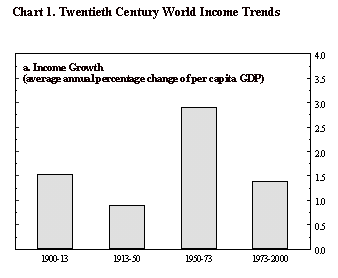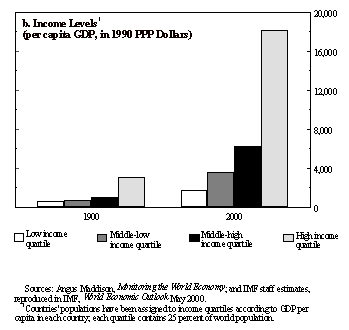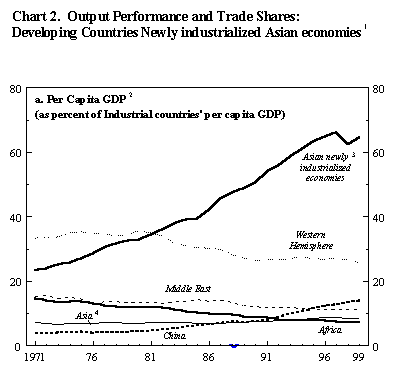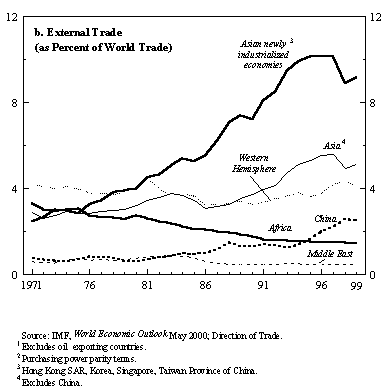I. Introduction
The term "globalization" has acquired considerable emotive force. Some view it
as a process that is beneficial—a key to future world economic development—and also inevitable
and irreversible. Others regard it with hostility, even fear, believing that it increases inequality
within and between nations, threatens employment and living standards and thwarts social
progress. This brief offers an overview of some aspects of globalization and aims to identify ways
in which countries can tap the gains of this process, while remaining realistic about its potential
and its risks.
Globalization offers extensive opportunities for truly worldwide development but it is not
progressing evenly. Some countries are becoming integrated into the global economy more
quickly than others. Countries that have been able to integrate are seeing faster growth and
reduced poverty. Outward-oriented policies brought dynamism and greater prosperity to much of
East Asia, transforming it from one of the poorest areas of the world 40 years ago. And as living
standards rose, it became possible to make progress on democracy and economic issues such as
the environment and work standards.
By contrast, in the 1970s and 1980s when many countries in Latin America and Africa
pursued inward-oriented policies, their economies stagnated or declined, poverty increased and
high inflation became the norm. In many cases, especially Africa, adverse external developments
made the problems worse. As these regions changed their policies, their incomes have begun to
rise. An important transformation is underway. Encouraging this trend, not reversing it, is the best
course for promoting growth, development and poverty reduction.
The crises in the emerging markets in the 1990s have made it quite evident that the
opportunities of globalization do not come without risks—risks arising from volatile capital
movements and the risks of social, economic, and environmental degradation created by poverty.
This is not a reason to reverse direction, but for all concerned—in developing countries, in the
advanced countries, and of course investors—to embrace policy changes to build strong economies
and a stronger world financial system that will produce more rapid growth and ensure that
poverty is reduced.
How can the developing countries, especially the poorest, be helped to catch up? Does
globalization exacerbate inequality or can it help to reduce poverty? And are countries that
integrate with the global economy inevitably vulnerable to instability? These are some of the
questions covered in the following sections.
II. What is Globalization?
Economic "globalization" is a historical process, the result of human innovation
and technological progress. It refers to the increasing integration of economies around the world,
particularly through trade and financial flows. The term sometimes also refers to the movement of
people (labor) and knowledge (technology) across international borders. There are also broader
cultural, political and environmental dimensions of globalization that are not covered here.
At its most basic, there is nothing mysterious about globalization. The term has come into
common usage since the 1980s, reflecting technological advances that have made it easier and
quicker to complete international transactions—both trade and financial flows. It refers to an
extension beyond national borders of the same market forces that have operated for centuries at
all levels of human economic activity—village markets, urban industries, or financial centers.
Markets promote efficiency through competition and the division of labor—the specialization
that allows people and economies to focus on what they do best. Global markets offer greater
opportunity for people to tap into more and larger markets around the world. It means that they
can have access to more capital flows, technology, cheaper imports, and larger export markets.
But markets do not necessarily ensure that the benefits of increased efficiency are shared by all.
Countries must be prepared to embrace the policies needed, and in the case of the poorest
countries may need the support of the international community as they do so.
III. Unparalleled Growth, Increased Inequality:
20th Century Income Trends
Globalization is not just a recent phenomenon. Some analysts have argued that the world
economy was just as globalized 100 years ago as it is today. But today commerce and financial
services are far more developed and deeply integrated than they were at that time. The most
striking aspect of this has been the integration of financial markets made possible by modern
electronic communication.
The 20th century saw unparalleled economic growth, with global per capita
GDP increasing almost five-fold. But this growth was not steady—the strongest expansion came
during the second half of the century, a period of rapid trade expansion accompanied by
trade—and typically somewhat later, financial—liberalization. Figure 1a breaks the century into four
periods.1 In the inter-war era, the world turned its back
on internationalism—or globalization as we now call it—and countries retreated into closed
economies, protectionism and pervasive capital controls. This was a major factor in the
devastation of this period, when per capita income growth fell to less than 1 percent during
1913-1950. For the rest of the century, even though population grew at an unprecedented pace,
per capita income growth was over 2 percent, the fastest pace of all coming during the
post-World War boom in the industrial countries.
The story of the 20th century was of remarkable average income growth, but
it is also quite obvious that the progress was not evenly dispersed. The gaps between rich and
poor countries, and rich and poor people within countries, have grown. The richest quarter of the
world’s population saw its per capita GDP increase nearly six-fold during the century, while the
poorest quarter experienced less than a three-fold increase (Chart 1b). Income inequality has
clearly increased. But, as noted below, per capita GDP does not tell the whole story (see section
IV).
IV. Developing countries: How deeply integrated?
Globalization means that world trade and financial markets are becoming more integrated.
But just how far have developing countries been involved in this integration? Their experience in
catching up with the advanced economies has been mixed. Chart 2a shows that in some countries,
especially in Asia, per capita incomes have been moving quickly toward levels in the industrial
countries since 1970. A larger number of developing countries have made only slow progress or
have lost ground. In particular, per capita incomes in Africa have declined relative to the industrial
countries and in some countries have declined in absolute terms. Chart 2b illustrates part of the
explanation: the countries catching up are those where trade has grown strongly.
Consider four aspects of globalization:
- Trade: Developing countries as a whole have increased their share of world
trade–from 19 percent in 1971 to 29 percent in 1999. But Chart 2b shows great variation among
the major regions. For instance, the newly industrialized economies (NIEs) of Asia have done
well, while Africa as a whole has fared poorly. The composition of what countries export is also
important. The strongest rise by far has been in the export of manufactured goods. The share of
primary commodities in world exports—such as food and raw materials—that are often produced by
the poorest countries, has declined.
- Capital movements: Chart 3 depicts what many people associate with globalization,
sharply increased private capital flows to developing countries during much of the 1990s. It also
shows that (a) the increase followed a particularly "dry" period in the 1980s; (b) net
official flows of "aid" or development assistance have fallen significantly since the
early 1980s; and (c) the composition of private flows has changed dramatically. Direct foreign
investment has become the most important category. Both portfolio investment and bank credit
rose but they have been more volatile, falling sharply in the wake of the financial crises of the late
1990s.
- Movement of people: Workers move from one country to another partly to find
better employment opportunities. The numbers involved are still quite small, but in the period
1965-90, the proportion of labor forces round the world that was foreign born increased by about
one-half. Most migration occurs between developing countries. But the flow of migrants to
advanced economies is likely to provide a means through which global wages converge. There is
also the potential for skills to be transferred back to the developing countries and for wages in
those countries to rise.
- Spread of knowledge (and technology): Information exchange is an integral, often
overlooked, aspect of globalization. For instance, direct foreign investment brings not only an
expansion of the physical capital stock, but also technical innovation. More generally, knowledge
about production methods, management techniques, export markets and economic policies is
available at very low cost, and it represents a highly valuable resource for the developing
countries.
The special case of the economies in transition from planned to market economies—they too
are becoming more integrated with the global economy—is not explored in much depth here. In
fact, the term "transition economy" is losing its usefulness. Some countries (e.g.
Poland, Hungary) are converging quite rapidly toward the structure and performance of advanced
economies. Others (such as most countries of the former Soviet Union) face long-term structural
and institutional issues similar to those faced by developing countries.





Source: IMF World Economic Outlook Databases: (May 2000), Direction of Trade
1/ Excludes oil exporting countries.
2/ Consists largely of bank lending.
V. Does Globalization Increase Poverty and Inequality?
During the 20th century, global average per capita income rose strongly, but with
considerable variation among countries. It is clear that the income gap between rich and poor
countries has been widening for many decades. The most recent World Economic
Outlook studies 42 countries (representing almost 90 percent of world population) for which
data are available for the entire 20th century. It reaches the conclusion that output
per capita has risen appreciably but that the distribution of income among countries has become
more unequal than at the beginning of the century.
But incomes do not tell the whole story; broader measures of welfare that take account of
social conditions show that poorer countries have made considerable progress. For instance, some
low-income countries, e.g. Sri Lanka, have quite impressive social indicators. One recent paper2 finds that if countries are compared using the UN’s
Human Development Indicators (HDI), which take education and life expectancy into account,
then the picture that emerges is quite different from that suggested by the income data alone.
Indeed the gaps may have narrowed. A striking inference from the study is a contrast between
what may be termed an "income gap" and an "HDI gap". The
(inflation-adjusted) income levels of today’s poor countries are still well below those of the
leading countries in 1870. And the gap in incomes has increased. But judged by their
HDIs, today’s poor countries are well ahead of where the leading countries were in 1870. This is
largely because medical advances and improved living standards have brought strong increases in
life expectancy.
But even if the HDI gap has narrowed in the long-term, far too many people are losing
ground. Life expectancy may have increased but the quality of life for many has not improved,
with many still in abject poverty. And the spread of AIDS through Africa in the past decade is
reducing life expectancy in many countries.
This has brought new urgency to policies specifically designed to alleviate poverty. Countries
with a strong growth record, pursuing the right policies, can expect to see a sustained reduction in
poverty, since recent evidence suggests that there exists at least a one-to-one correspondence
between growth and poverty reduction. And if strongly pro-poor policies—for instance in
well-targeted social expenditure—are pursued then there is a better chance that growth will be
amplified into more rapid poverty reduction. This is one compelling reason for all economic policy
makers, including the IMF, to pay heed more explicitly to the objective of poverty reduction.
VI. How Can the Poorest Countries Catch Up More
Quickly?
Growth in living standards springs from the accumulation of physical capital (investment) and
human capital (labor), and through advances in technology (what economists call total factor
productivity).3 Many factors can help or hinder these
processes. The experience of the countries that have increased output most rapidly shows the
importance of creating conditions that are conducive to long-run per capita income growth.
Economic stability, institution building, and structural reform are at least as important for
long-term development as financial transfers, important as they are. What matters is the whole
package of policies, financial and technical assistance, and debt relief if necessary.
Components of such a package might include:
- Macroeconomic stability to create the right conditions for investment and saving;
- Outward oriented policies to promote efficiency through increased trade and
investment;
- Structural reform to encourage domestic competition;
- Strong institutions and an effective government to foster good governance;
- Education, training, and research and development to promote productivity;
- External debt management to ensure adequate resources for sustainable
development.
All these policies should be focussed on country-owned strategies to reduce poverty by
promoting pro-poor policies that are properly budgeted—including health, education, and strong
social safety nets. A participatory approach, including consultation with civil society, will add
greatly to their chances of success.
Advanced economies can make a vital contribution to the low-income countries’ efforts to
integrate into the global economy:
- By promoting trade. One proposal on the table is to provide unrestricted market access for
all exports from the poorest countries. This should help them move beyond specialization on
primary commodities to producing processed goods for export.
- By encouraging flows of private capital to the lower-income countries, particularly foreign
direct investment, with its twin benefits of steady financial flows and technology
transfer.
- By supplementing more rapid debt relief with an increased level of new financial support.
Official development assistance (ODA) has fallen to 0.24 percent of GDP (1998) in advanced
countries (compared with a UN target of 0.7 percent). As Michel Camdessus, the former
Managing Director of the IMF put it: "The excuse of aid fatigue is not credible—indeed it
approaches the level of downright cynicism—at a time when, for the last decade, the advanced
countries have had the opportunity to enjoy the benefits of the peace dividend."
The IMF supports reform in the poorest countries through its new Poverty Reduction and
Growth Facility. It is contributing to debt relief through the initiative for the heavily indebted poor
countries.4
VII. An Advanced Country Perspective:
Does Globalization
Harm Workers’ Interests?
Anxiety about globalization also exists in advanced economies. How real is the perceived
threat that competition from "low-wage economies" displaces workers from
high-wage jobs and decreases the demand for less skilled workers? Are the changes taking place
in these economies and societies a direct result of globalization?
Economies are continually evolving and globalization is one among several other continuing
trends. One such trend is that as industrial economies mature, they are becoming more
service-oriented to meet the changing demands of their population. Another trend is the shift
toward more highly skilled jobs. But all the evidence is that these changes would be taking
place—not necessarily at the same pace—with or without globalization. In fact, globalization is
actually making this process easier and less costly to the economy as a whole by bringing the
benefits of capital flows, technological innovations, and lower import prices. Economic growth,
employment and living standards are all higher than they would be in a closed economy.
But the gains are typically distributed unevenly among groups within countries, and some
groups may lose out. For instance, workers in declining older industries may not be able to make
an easy transition to new industries.
What is the appropriate policy response? Should governments try to protect particular
groups, like low-paid workers or old industries, by restricting trade or capital flows? Such an
approach might help some in the short-term, but ultimately it is at the expense of the living
standards of the population at large. Rather, governments should pursue policies that encourage
integration into the global economy while putting in place measures to help those adversely
affected by the changes. The economy as a whole will prosper more from policies that embrace
globalization by promoting an open economy, and, at the same time, squarely address the need to
ensure the benefits are widely shared. Government policy should focus on two important areas:
- education and vocational training, to make sure that workers have the opportunity to acquire
the right skills in dynamic changing economies; and
- well-targeted social safety nets to assist people who are displaced.
VIII. Are Periodic Crises an Inevitable Consequence of
Globalization?
The succession of crises in the 1990s—Mexico, Thailand, Indonesia, Korea, Russia, and
Brazil—suggested to some that financial crises are a direct and inevitable result of globalization.
Indeed one question that arises in both advanced and emerging market economies is whether
globalization makes economic management more difficult (Box 1).
|
Box 1. Does globalization reduce national sovereignty in economic
policy-making?
Does increased integration, particularly in the financial sphere make it more difficult for
governments to manage economic activity, for instance by limiting governments’ choices of tax
rates and tax systems, or their freedom of action on monetary or exchange rate policies? If it is
assumed that countries aim to achieve sustainable growth, low inflation and social progress, then
the evidence of the past 50 years is that globalization contributes to these objectives in the long
term.
In the short-term, as we have seen in the past few years, volatile short-term capital flows can
threaten macroeconomic stability. Thus in a world of integrated financial markets, countries will
find it increasingly risky to follow policies that do not promote financial stability. This discipline
also applies to the private sector, which will find it more difficult to implement wage increases and
price markups that would make the country concerned become uncompetitive.
But there is another kind of risk. Sometimes investors—particularly short-term investors—take
too sanguine a view of a country’s prospects and capital inflows may continue even when
economic policies have become too relaxed. This exposes the country to the risk that when
perceptions change, there may be a sudden brutal withdrawal of capital from the country.
In short, globalization does not reduce national sovereignty. It does create a strong incentive
for governments to pursue sound economic policies. It should create incentives for the private
sector to undertake careful analysis of risk. However, short-term investment flows may be
excessively volatile.
Efforts to increase the stability of international capital flows are central to the ongoing work
on strengthening the international financial architecture. In this regard, some are concerned that
globalization leads to the abolition of rules or constraints on business activities. To the
contrary—one of the key goals of the work on the international financial architecture is to develop
standards and codes that are based on internationally accepted principles that can be implemented
in many different national settings. |
Clearly the crises would not have developed as they did without exposure to global capital
markets. But nor could these countries have achieved their impressive growth records without
those financial flows.
These were complex crises, resulting from an interaction of shortcomings in national policy
and the international financial system. Individual governments and the international community as
a whole are taking steps to reduce the risk of such crises in future.
At the national level, even though several of the countries had impressive records of
economic performance, they were not fully prepared to withstand the potential shocks that could
come through the international markets. Macroeconomic stability, financial soundness, open
economies, transparency, and good governance are all essential for countries participating in the
global markets. Each of the countries came up short in one or more respects.
At the international level, several important lines of defense against crisis were breached.
Investors did not appraise risks adequately. Regulators and supervisors in the major financial
centers did not monitor developments sufficiently closely. And not enough information was
available about some international investors, notably offshore financial institutions. The result was
that markets were prone to "herd behavior"— sudden shifts of investor sentiment and
the rapid movement of capital, especially short-term finance, into and out of countries.
The international community is responding to the global dimensions of the crisis through a
continuing effort to strengthen the architecture of the international monetary and financial system.
The broad aim is for markets to operate with more transparency, equity, and efficiency. The IMF
has a central role in this process, which is explored further in separate fact sheets.5
IX. The Role of Institutions and Organizations
National and international institutions, inevitably influenced by differences in culture, play an
important role in the process of globalization. It may be best to leave an outside commentator to
reflect on the role of institutions:
"...That the advent of highly integrated commodity and financial markets has been
accompanied by trade tensions and problems of financial instability should not come as a surprise,
...... The surprise is that these problems are not even more severe today, given that the extent of
commodity and financial market integration is so much greater.
" One possibility in accounting (for this surprise) is the stabilizing role of the
institutions built in the interim. At the national level this means social and financial safety nets. At
the international level it means the WTO, the IMF, the Basle Committee of Banking Supervisors.
These institutions may be far from perfect, but they are better than nothing, judging from the
historical correlation between the level of integration on one hand and the level of trade conflict
and financial instability on the other."6 (parentheses
added)
X. Conclusion
As globalization has progressed, living conditions (particularly when measured by broader
indicators of well being) have improved significantly in virtually all countries. However, the
strongest gains have been made by the advanced countries and only some of the developing
countries.
That the income gap between high-income and low-income countries has grown wider is a
matter for concern. And the number of the world’s citizens in abject poverty is deeply
disturbing. But it is wrong to jump to the conclusion that globalization has caused the divergence,
or that nothing can be done to improve the situation. To the contrary: low-income countries have
not been able to integrate with the global economy as quickly as others, partly because of their
chosen policies and partly because of factors outside their control. No country, least of all the
poorest, can afford to remain isolated from the world economy. Every country should seek to
reduce poverty. The international community should endeavor—by strengthening the international
financial system, through trade, and through aid—to help the poorest countries integrate into the
world economy, grow more rapidly, and reduce poverty. That is the way to ensure all people in all
countries have access to the benefits of globalization.
1 The discussion in this section is elaborated in the World Economic Outlook,
International Monetary Fund, Washington D.C., May 2000.
2 Nicholas Crafts, Globalization and Growth in the
Twentieth Century, IMF Working Paper, WP/00/44, Washington DC, April 2000.
3 These issues are explored in greater depth in IMF, World Economic Outlook, May 2000,
Chapter IV.
4 These are described in the factsheets "The Poverty Reduction and Growth Facility
(PRGF) - Operational Issues", and "Overview: Transforming the Enhanced Structural
Adjustment Facility (ESAF) and the Debt Initiative for the Heavily Indebted Poor Countries
(HIPCs)," which may be viewed at www.imf.org.
5 See "Progress in Strengthening the Architecture of the International Monetary
System": http://0-wwww-imf-org.library.svsu.edu/external/np/exr/facts/arcguide.ht
m and Guide to Progress in Strengthening of the International Financial System: http://0-www-imf-org.library.svsu.edu/external/np/exr/facts/arcguide.htm.
6 Bordo, Michael D., Barry Eichengreen, and Douglas A. Irwin, Is Globalization
Today Really Different than Globalization a Hundred Years Ago? Working Paper 7195, National
Bureau of Economic Research, Cambridge, MA, June 1999.
|